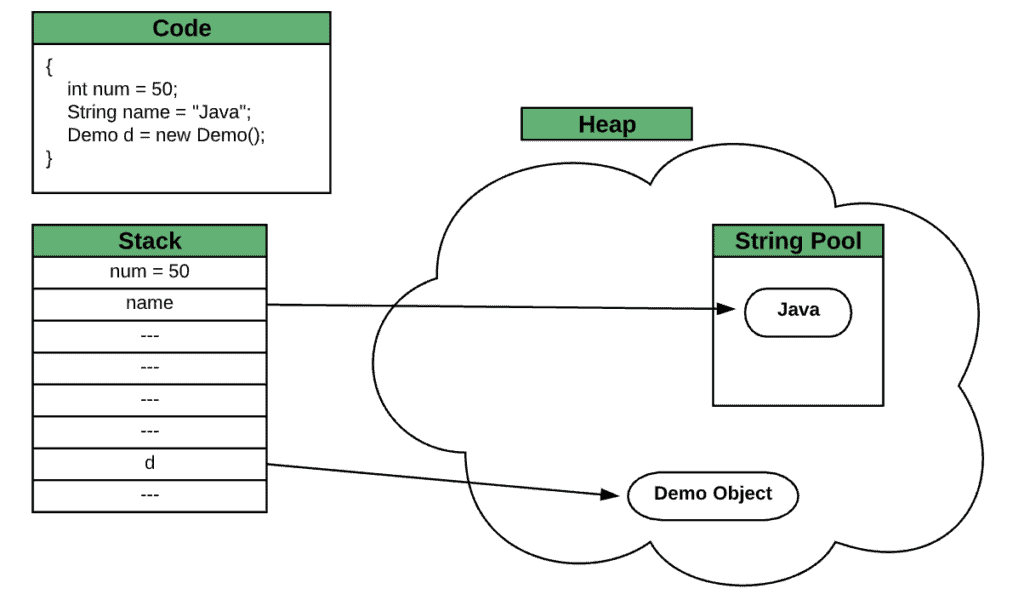1. 引言
在 Java 中,每当我们声明变量或创建对象时,它们都会被存储到内存中。从宏观上看,Java 将内存划分为两个主要区域:栈(stack)和堆(heap)。这两个内存区域用于存储不同类型的数据,并且在访问和管理方式上也存在显著差异。
本文将通过分析内存分配机制、数据访问特性等角度,来探讨 String 常量池 最适合存放的位置。
2. 字符串常量池(String Constant Pool)
字符串常量池是 JVM 内部一个特殊的内存区域。当我们使用字符串字面量(literal)方式声明字符串时,JVM 会首先检查常量池中是否已经存在相同内容的字符串:
- ✅ 如果存在,则直接返回已有对象的引用;
- ❌ 如果不存在,则在常量池中创建一个新的字符串对象,并将其引用返回。
这个机制有助于减少重复字符串带来的内存开销。
实现机制
常量池底层其实是由一个 HashMap 结构实现的:
- 每个 bucket 存储着具有相同哈希值的字符串列表;
- 在早期版本的 Java 中(如 JDK 6),字符串常量池位于 永久代(PermGen) 中,是一块固定大小的内存区域,容易引发
OutOfMemoryError错误; - ⚠️ 自 JDK 7 起,字符串常量池被移到了 堆内存(heap) 中,从而可以动态扩展,避免因容量不足导致的问题。
数据共享与访问特性
当类加载器加载类时,其中的所有字符串字面量都会被放入应用级的常量池中。这是为了保证:
不同类中的相同字符串字面量必须指向同一个对象。
因此,字符串常量池需要具备全局可访问的能力,而这一点只有堆内存能够满足:
| 特性 | 栈(Stack) | 堆(Heap) |
|---|---|---|
| 生命周期 | 短暂,随方法调用结束而销毁 | 长久,由 GC 回收 |
| 访问方式 | 连续内存块,LIFO | 动态分配,支持随机访问 |
| 多线程可见性 | 私有作用域,仅当前线程可见 | 全局可见,所有线程共享 |
| 是否支持动态扩容 | 否 | 是 |
从上面可以看出,栈内存并不适合存储像字符串常量池这样需要长期存在、全局共享的数据。
内存结构示意图
以下是一个简单的内存模型图,展示了栈和堆中不同类型数据的分布情况:
- 栈中保存的是局部变量和对象引用;
- 堆中实际存储对象本身;
- 字符串常量池作为堆的一部分,存储字符串对象的实际内容。
垃圾回收机制
栈中的变量随着方法执行完毕自动释放;而堆中的对象则由 垃圾收集器(Garbage Collector) 回收。字符串常量池也不例外,未被引用的字符串对象最终也会被 GC 清理。
平台差异
虽然不同 JVM 实现可能对字符串常量池的具体大小有不同的默认配置,但总体来说:
✅ 堆内存远大于栈内存,更适合存储大量字符串对象。
3. 总结
综上所述,我们可以得出结论:
✅ Java 字符串常量池从来就不属于栈内存,而是从 JDK 7 开始就被移到了堆内存中。
这不仅解决了早期版本中因 PermGen 空间有限而导致的 OOM 问题,还提升了内存使用的灵活性和安全性。
如果你还在纠结“字符串常量池到底在哪”,现在可以放心大胆地说:
❗“它就在堆里!”
